Fish meal and fish oil use in aquaculture
Fish meal and fish oil use in aquaculture: global overview and prospects for substitution
Although aquaculture’s contribution toward total world fisheries landings has increased six-fold over the past three decades, increasing from 5.3% to 34.1% from 1970 to 2001 (Figure 1), the finfish and crustacean aquaculture sector is still highly dependent upon marine capture fisheries for sourcing key dietary nutrient inputs such as fish meal and fish oil. In fact when viewed in wet fish weight equivalents, although only about 17.7 million metric tons (mmt) or 37% of total global aquaculture production in 2001 (Figure 2) were finfish and crustacean species whose production was dependent upon the use of compound aquafeeds, these species consumed the equivalent of 17 to 21 mmt of marine pelagics on a wet weight basis.
This paper reviews the current and predicted global use and demand for fish meal and fish oil with compound aquafeeds for farmed finfish and crustaceans, including prospects for substitution; aquafeeds including commercially compounded diets, farm-made aquafeeds, and/or whole marine food/feed organisms as well as fresh/frozen fish, molluscs and crustaceans. Particular emphasis is placed on the urgent need for the aquafeed-fed finfish and crustacean aquaculture sector to reduce its current dependence upon potentially food-grade marine capture fishery resources for sourcing its major dietary protein and lipid nutrient inputs (in the form of fish meal and fish oil), and to seek alternative more sustainable feed resources; the long term evaluation and use of single cell proteins (SCP) being particularly encouraged and holding much promise.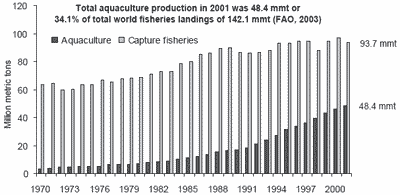
Figure 1.Contribution of aquaculture to total world fisheries landings 1970-2001.
Figure 2.Total world aquaculture production in 2001 (FAO, 2003).
Current fish meal and fish oil usage
As mentioned previously, the finfish and crustacean aquaculture sector is currently heavily dependent upon capture fisheries for sourcing key nutrients and feed ingredients for compound aquafeeds. These include high quality animal proteins and feeding attractants (fish meal, and to a lesser extent fish solubles, shrimp meal, squid meal, fish/squid liver meals, fish/ crustacean hydrolysates, and krill meal) and essential dietary lipids (fish oil, and to a lesser extent fish and squid liver oils); Hardy and Tacon, 2002; New and Wijkström, 2002; Tacon, 2003a). This dependency upon fish meal and fish oil is particularly strong for those higher value species feeding high on the aquatic food chain, including all carnivorous (i.e. fish/ invertebrate animal-eating) finfish species and most omnivorous/scavenging crustacean species.
Finfish and crustacean species that are currently reliant upon fish meal as the main source of dietary protein in compound aquafeeds include: finfish - all farmed marine finfish (excluding mullets and rabbitfish); diadromous species - salmonids (salmon, trout, char), eels, barramundi, sturgeon; freshwater species - mandarin fish, pike, pike-perch, snakehead, certain freshwater Clarias catfishes; and crustaceans - all marine shrimp, crabs, and freshwater prawns. A similar dependency also exists for fish oil (as the main source of dietary lipids and essential fatty acids in compound aquafeeds) for the above species, with crustaceans currently being less dependent than carnivorous finfish due to the lower levels of dietary lipids generally used in crustacean feeds. In addition to the above, fish meal and fish oil are also commonly used as a secondary source of dietary protein (usually included at low dietary inclusion levels) and lipid for many omnivorous cultured finfish species, including freshwater carps, tilapia and catfish (Tacon, 2003b).
Table 1 shows the estimated global use and demand for fish meal and fish oil within compound aquafeeds according to the author, with estimates from the International Fish Meal and Fish Oil Manufacturers Association (IFFO; Pike and Barlow, 2003) given in italics. From these data it can be seen that the total production of industrially compounded aquafeed production in 2001 was about 16.7 mmt (Figure 3), with aquafeed production currently representing only about 3% of total global industrial animal feed production (estimated at 612 mmt in 2003; Figure 4). The major species groups dependent upon compound aquafeeds in 2001 include the non-filter feeding carps (8.0 mmt of aquafeeds used in 2001), marine shrimp (2.1 mmt), salmon (1.56 mmt), marine finfish (excludes mullets; 1.21 mmt), tilapia (1.16 mmt), trout (0.74 mmt), catfish (0.60 mmt), freshwater crustaceans (0.52 mmt), milkfish (0.42 mmt) and eels (0.37 mmt; Figure 3).
Table 1. Estimated global use and demand for fish meal and fish oil within compound aquafeeds (2001 species group aquaculture production estimates taken from FAO, 2003)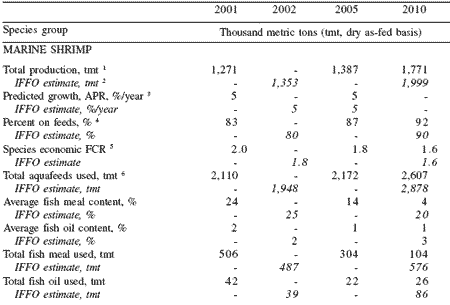
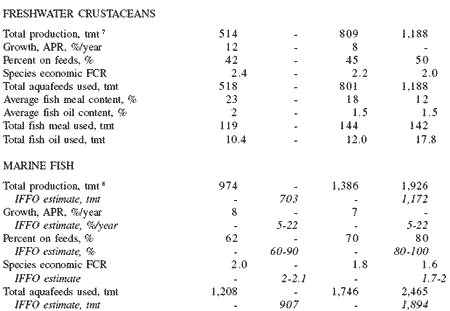

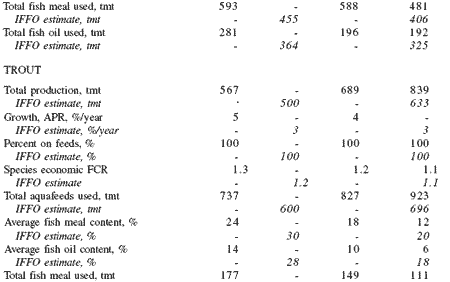
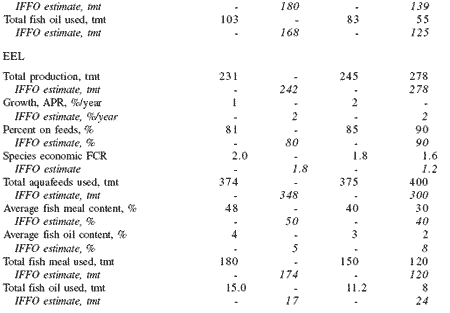
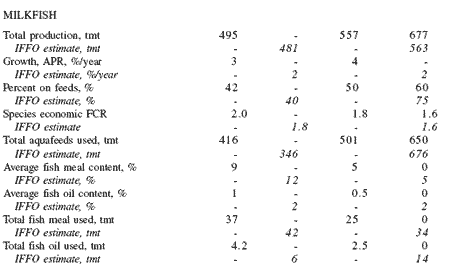

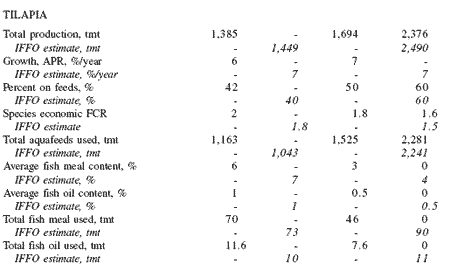

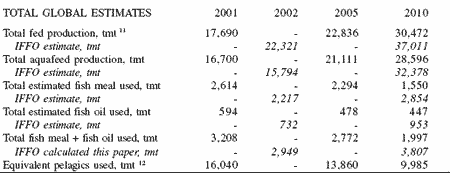
1 Total reported farmed species group production for 2001 (FAO, 2003), and estimates for 2005 and 2010 (Tacon, 2003b)
2 International Fish meal and Fish Oil Organization (IFFO) estimated farmed marine shrimp + crab production for 2002 and estimates for 2005 and 2010 (Pike and Barlow, 2003)
3 Estimated Annual Percent Rate of Growth of farmed species group production 2001/2002 to 2010 (APR, %)
4 Estimated percent of total species group production on aquafeeds
5 Estimated average species group economic food conversion ratio (total food fed / total species group biomass increase)
6 Estimated total species group aquafeed used (total species group production x FCR)
7 Freshwater crustaceans includes freshwater prawn, river crab and crayfish
8 Marine finfish species group excludes mullets
9 Feeding carp species excludes filter feeders such as silver carp, big head carp and catla
10 Includes Chinese bream, mandarin fish, yellow croakere, long-nose catfish (carnivorous/omnivorous) but excludes eel (Pike and Barlow, 2003)
11 Excludes filter feeding fish species (5,878 tmt in 2001), freshwater fish species (species unknown: 2,259 tmt in 2001), marine crabs and other marine crustaceans (200 tmt), Mandarin fish (116 tmt in 2001), and other miscellaneous freshwater fish species (including climbing perch, snakeheads, colossoma, gourami ca. 165 tmt in 2001).
12 Using a mean fish meal+fish oil to pelagics conversion ratio of 1:5 (FAO conversion factor for fish meal).
Concerning fish meal and fish oil usage, it is estimated that the compound aquafeed sector consumed about 2.62 mmt of fish meal and 0.59 mmt of fish oil in 2001 (Table 1), or equivalent to 43.1% and 53.6% of the total global production of fish meal (6.08 mmt) and fish oil (1.10 mmt), respectively (FAO, 2003).
On a species group level salmonids consumed the largest proportion of fish meal and fish oil in 2001 (29.4% and 64.5% of totals used in aquafeeds, respectively), followed by marine fish (22.6% and 20.3%), marine shrimp (19.3% and 7.0%), feeding carp (15.3% in the case of fish meal) and eels (6.9% and 2.5%; Figures 5 and 6). The total use of fish meal and fish oil in compound aquafeeds is almost certainly higher than the figure given above, as an additional 2.6 mmt of finfish and crustacean production (equivalent to 10% total finfish and crustacean production) was not included in these calculations (includes unknown freshwater fish species (2.26 mmt in 2001), marine crabs and other marine crustaceans (0.2 mmt), Mandarin fish (0.12 mmt), and other miscellaneous freshwater fish species). According to IFFO (Pike and Barlow, 2003) fish meal and fish oil usage within compound aquafeeds in 2002 was estimated to be 2.22 mmt and 0.73 mmt, respectively (Table 1).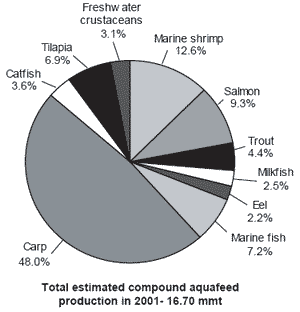
Figure 3. Estimated global compound aquafeed production in 2001 for major farmed species (values expressed as % total aquafeed production, dry as-fed basis).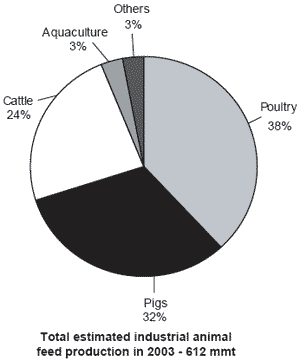
Figure 4.Estimated global industrial animal feed production in 2001 for major farmed species (values expressed as % dry as-fed basis).
The total estimated use of fish meal and fish oil in aquafeeds (3.2 mmt in 2001, dry basis) was equivalent to the use of 12.8 to 16.1 mmt of pelagics (using a dry meal/oil to wet fish weight equivalents conversion factor of 4 to 5) for the production of 17.69 mmt of the major farmed-fed finfish and crustacean species in 2001. Cultured species groups currently consuming more fish through feeding than is being produced through farming in 2001 included marine eels (current pelagic input per unit of production 3.4- 4.2), marine fish (2.9-3.7), salmonids (2.6-3.3), marine shrimp (1.7-2.1), freshwater crustaceans (1.0- 1.3), whereas, net fish producers included milkfish (0.33-0.42), catfish (0.28-0.35), tilapia (0.24-0.29), and feeding carp (0.15-0.19).
Moreover, coupled with the use of trash fish as a direct food source for farmed fish and crustaceans in some Asian countries (China reportedly using 4 mmt of trash fish as feed for marine finfish and crustaceans in 2000; D’Abramo et al., 2002), it is estimated that the aquaculture sector consumed the equivalent of 17-20 mmt of fish as feed in 2001 (either in the form of fish meal, fish oil or trash fish, expressed in live weight equivalents) for the total production of 17.69 mmt of aquafeed-based farmed fish and crustaceans in 2001. However, in contrast to the 8 to 11% annual growth rate of the aquaculture sector over the past decade, the proportion of the global fish catch destined for non-food uses (including for reduction into fish meal and fish oil, or for direct animal feeding) has remained relatively constant, in recent years fluctuating from a low of 25.3 mmt in 1998 (strong El Niño year) to a high of 34.8 mmt in 2000 (Figure 7); total capture fisheries in 2001 reported as 92.4 mmt, including 61.1 mmt destined for direct human consumption and 31.3 mmt or 33.9% destined for non-food uses (FAO, 2003).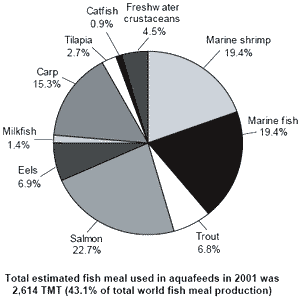
Figure 5.Estimated global use of fishmeal in compound aquafeeds in 2001 by major cultivated species (expressed as % total fish meal used within aquafeeds, dry as-fed basis).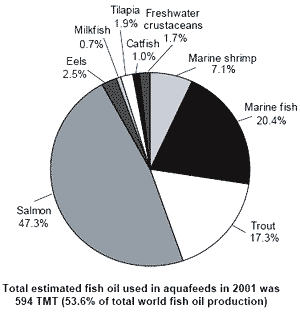
Figure 6.Estimated global use of fish oil in compound aquafeeds in 2001 by major cultivated species (expressed as % total fish meal used within aquafeeds, dry as-fed basis).
Future fish meal and fish oil usage It follows from the above discussion that for those aquaculture species and exporting/importing countries currently dependent upon the use of these relatively finite fishery commodities as feed inputs, consumption of these commodities will have to increase if current dietary inclusion levels are to be maintained. For example, according to IFFO (Barlow and Pike, 2003) the aquaculture sector’s consumption of fish meal and fish oil is expected to increase from 34% (2,217 tmt) and 56% (732 tmt) of the total global production of fish meal and fish oil in 2002, to 48% (2,854 tmt) and 79% (953 tmt) in 2010, respectively (Table 1); this increase being equivalent to a 29-30% increase in global fish meal and fish oil usage by the aquaculture sector from 2002 to 2010.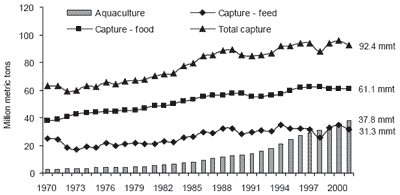
Figure 7.World finfish and shellfish production from capture fisheries and aquaculture, and disposition of the catch 1970-2001 (expressed in million metric tons, live weight equivalents; FAO, 2003).
The above predictions by IFFO differ from those of the present author and others (Hardy and Tacon, 2002; Tacon and Forster, 2000), who estimated that fish meal and fish oil use by the aquaculture sector will actually decrease rather than increase in the long term (Table 1). Thus, from the data presented in Table 1 it is expected that usage will decrease by 40% in the case of fish meal (from 2,614 tmt in 2001 to 1,550 tmt in 2010) and 25% in the case of fish oil (from 594 tmt in 2001 to 447 tmt in 2010, Table 1).
The main reasons why fish meal and fish oil use by the aquaculture sector is expected to decrease in the long term is due to a combination of increasing economic/market pressures placed upon the fish meal and fish oil manufacturing industry and animal feed compounder on the one hand; and the consequent search, development and use of lower cost and more sustainable alternatives by the aquafeed manufacturing sector on the other hand so as to maintain profitability and sustain the growth of the feed-dependent aquaculture sector. Examples of increasing economic/market pressures placed upon the fish meal/aquafeed manufacturing sector include:
• The increasing market demand for the production and use of less environmentally contaminated fish meals and oils (through the selection of less contaminated fish stocks and/or through increasing legislative controls limiting fish meal/ fish oil use in aquafeeds; Hites et al., 2004; Jacobs et al., 2002; Pike, 2002; Smith et al., 2002),
• The increasing global demand for the use of potentially food-grade pelagics (including mackerel, sardines, herring, pilchards, anchovies) for direct human consumption rather than for reduction into fish meal and fish oil (Wray, 2001),
• Increased global competition for available stocks of fish meal and fish oil by the rapidly emerging aquafeeds and compound animal feed manufacturing sector in developing countries (including China, Thailand, Indonesia, India, Chile, Brazil) D’Abramo et al., 2002; FAO, 2003; Tacon, 2003a; Figure 4),
• A global trend toward increasing fish meal and fish oil prices with increasing market demand for these valuable commodities (Hinrichsen, 2003),
• Increasing consumer awareness for increased food/feed safety and traceability in the food production process (Best, 2002; Soponpong, 2002), the environmental, ecological and social sustainability of our food production (Costa- Pierce, 2003; Hole, 2004; Naylor et al., 1998; Raven, 2002; Tacon, 1997), and consumer demand for leaner and healthier food products.
Moreover, as a result of increased aquaculture production and decreasing fish/shrimp market prices (Harvey, 2003; Hinrichsen, 2003), nutritionists and feed manufacturers alike have been forced to reduce feed costs (through the development of fish meal and fish oil replacers) and/or by improving on-farm feed performance so as to maintain profitability.
Sustaining aquaculture production: substitution prospects
Clearly, in view of the fact that wild fish stocks have remained relatively static over the last decade (Figure 7), the aquaculture sector has no choice but to reduce its dependence upon capture fisheries for sourcing its dietary protein and lipid nutrient inputs if it is to sustain its annual growth rate of 8.8% per year since 1970 (Figure 1). Although this will be a relatively simple task for omnivorous/herbivorous finfish and crustacean species (in view of their more flexible feeding habits/food preferences and available feed resources), this will be more difficult for carnivorous species.
To date the majority of recent effort has focused on the development and use of the following major fish meal replacers:
Terrestrial vegetable proteins (TVP), includes protein-rich oilseed and grain by-product meals including soybean, rapeseed, corn gluten, wheat gluten, and to a lesser extent pea and lupin meals (Abdelghany, 2003; Abery et al., 2002; Barros et al., 2002; Bautista-Teruel et al., 2003a, 2003b; Borlongan et al., 2003; Cheng and Hardy, 2002a; Cheng et al., 2003; Cremer et al., 2003; Du and Niu, 2003; Farhangi and Carter, 2001; Francis et al., 2001; Glencross et al., 2003a, 2003b, 2003d; Grisdale- Helland et al., 2002; Hari and Kurup, 2003; Jahan et al., 2003; Lee et al., 2002; Maina et al., 2003; Mente et al., 2003; Opstvedt et al., 2003a, 2003b; Penaflorida, 2002; Pereira and Oliva-Teles, 2002; Peres et al., 2003; Refstie and Tiekstra, 2003; Richter et al., 2003; Rinchard et al., 2002; Dabrowski et al., 2003; Siddhuraju and Becker, 2003; Singh et al., 2003; Takagi et al., 2001; Thiessen et al., 2003a, 2003b). According to the FAO agricultural statistical database the total production of plant oil cakes and meals in 2002 was over 177 mmt (Figure 8), as compared with a total global production of just over 7 mmt for fish meal and fish oil.
Terrestrial animal proteins (TAP), includes animal by-product meals: poultry by-product meal, meat meal, meat and bone meal, and to a lesser extent feather meal and blood meal (Abdel-Warith et al., 2001; Bharadwaj et al., 2002; Cheng and Hardy, 2002b; Cheng et al., 2002; Forster et al., 2003; Mendoza et al., 2001; Menasveta et al., 2003; Millamena and Golez, 2001; Millamena, 2002; Tan et al., 2003; Williams et al., 2003a, 2003b; Woodgate, 2004a, 2004b; Zhu and Yu, 2003).
Single cell proteins (SCP), includes unicellular and filamentous algae, yeasts and bacteria (Lara-Flores et al., 2003; Li and Gatlin, 2003; Nates and Tacon, 2003; Nates et al., 2002; Olvera-Novoa et al., 2003). Of the above-mentioned feed sources, considerable further work still needs to be undertaken concerning the use and suitability of SCP as dietary fish meal replacers for both finfish and crustaceans. These products hold particular promise by virtue of their ability to be produced from renewable resources and/ or agricultural/petrochemical waste streams/ substrates, their rapid growth rate, high dietary protein content and nutritive value (generally devoid of anti-nutrients and overt nutrient imbalances), and the ability to tailor their nutritional composition to approximate needs of the cultured target species (through direct nutrient modifications during the fermentation or growth process).
Finally, total replacement of fish oil with commercially available plant and animal oils has been more problematic, especially within carnivorous marine and diadromous finfish species. Studies where plant and animal oils (including soybean, rapeseed, linseed oils and terrestrial animal fats) have achieved some success as fish oil replacers (depending upon the species farmed) have included: Ballestrazzi, 2003; Bell et al., 2002, 2003a, 2003b; Bransden et al., 2003; Bureau, 2004; Grisdale-Helland et al., 2002b; Glencross et al. 2003c; Martino, 2003; Montero et al., 2003; Ng et al., 2003; Raso and Anderson, 2003; Regost et al., 2003a, 2003b; Tocher et al., 2002; Turchini et al., 2003. However, as in the case of dietary protein sources, considerable potential also exists concerning the further development and use of SCP for the production of dietary lipid supplements and ingredients rich in long chain polyunsaturated fatty acids and other essential lipid soluble nutrients, including carotenoid antioxidants, phospholipids, specific steroids etc. (Nates and Tacon, 2003b).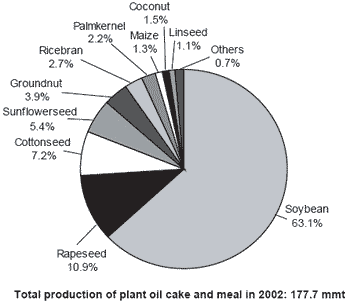
Figure 8.Estimated global production of plant oilseed cakes and meals in 2002 (source: FAOSTAT Agriculture Database).
Clearly, the long term sustainability of the aquaculture and compound aquafeed sectors will only be ensured if ingredients can be sourced whose production can keep pace with the growth of the sector (including the competing terrestrial livestock meat production sector; Figure 9), and whose nutritional composition and characteristics are flexible and can be tailored to the growth and ever changing requirements of the sector.
Figure 9. Total global farmed terrestrial and aquatic meat production 1970-2001 (source: FAOSTAT, 20034).
References
Author: ALBERT G.J. TACONAbdelghany, A. 2003. Partial and complete replacement of fish meal with gambusia meal in diets for red tilapia ‘Oreochromis niloticus x O. mossambicus’. Aquacult. Nutr. 9(3):145-154.
Abdel-Warith, A.A., P.M. Russell and S.J. Davies. 2001. Inclusion of a commercial poultry by-product meal as a protein replacement of fish meal in practical diets for African catfish Clarias gariepinus (Burchell 1822). Aquacult. Res. 32(1):296-305.
Abery, N.W., R.M. Gunasekera, S.S. DeSilva. 2002. Growth and nutrient utilization of Murray cod Maccullochella peelii peelii (Mitchell) fingerlings fed diets with varying levels of soybean meal and blood meal. Aquacult. Res. 33(4):279-289.
Ballestrazzi, R., S. Rainis, F. Tulli and A. Bracelli. 2003. The effect of dietary coconut oil on reproductive traits and egg fatty acid composition in rainbow trout (Oncorhynchus mykiss). Aquacult. Int. 11(3):289-299.
Barros, M.M., C. Lim and P.H. Klesius. 2002. Effect of soybean meal replacement by cottonseed meal and iron supplementation on growth, immune response and resistance of channel catfish (Ictalurus puctatus) to Edwardsiella ictaluri challenge. Aquaculture 207(3):263-279.
Bautista-Teruel, M.N., P.S. Eusebio and T.P. Welsh. 2003a. Utilization of feed pea, Pisum sativum, meal as a protein source in practical diets for juvenile tiger shrimp, Penaeus monodon. Aquaculture 225(1-4):121-131.
Bautista-Teruel, M.N., A.C. Fermin and S.S. Koshio. 2003b. Diet development and evaluation for juvenile abalone, Haliotis asinina: animal and plant protein sources. Aquaculture 219(1-4):645-653.
Bell, J.G., D.R. Tocher, R.J. Henderson, D.R. Tocher, F. McGhee, J.R. Dick, A. Porter, R.P. Smullen and J.R. Sargent. 2002. Substituting fish oil with crude palm oil in the diet of Atlantic salmon (Salmo salar) affects muscle fatty acid composition and hepatic fatty acid metabolism. J. Nutr. 132:222-230.
Bell, J.G., D.R. Tocher, R.J. Henderson, J.R. Dick and V.O. Crampton. 2003a. Altered fatty acid compositions in Atlantic salmon (Salmo salar) fed diets containing linseed and rapeseed oils can be partially restored by a subsequent fish oil finishing diet. J. Nutr. 133:2793-2801.
Bell, J.G., F. McGhee, P.J. Campbell and J.R. Sargent. 2003b. Rapeseed oil as an alternative to marine fish oil in diets of post-smolt Atlantic salmon (Salmo salar): changes in flesh fatty acid composition and effectiveness of subsequent fish oil ‘wash out’. Aquaculture 218(1-4):515-528.
Bharadwaj, A.S., W.R. Brignon, N.L. Gould, P.B. Brown and Y.V. Wu. 2002. Evaluation of meat and bone meal in practical diets fed to juvenile hybrid striped bass Morone chrysops x M. saxatilis. J. World Aqua. Soc. 33(4):448-457.
Best, P. 2002. Tracking consumer desires: towards total traceability of feed and food. Feed Int. 23(2):4.
Borlongan, I.G., P.S. Eusebio and T. Welsh. 2003. Potential of feed pea (Pisum sativum) meal as a protein source in practical diets for milkfish (Chanos chanos Forsskal). Aquaculture 225(1- 4):89-98.
Bransden, M.P., C.G. Carter and P.D. Nichols. 2003. Replacement of fish oil with sunflower oil in feeds for Atlantic salmon (Salmo salar L.): effect on growth performance, tissue fatty acid composition and disease resistance. Comp. Biochem. Physiol., Part B 135(4):611-625.
Bureau, D.P. 2004. Animal fats as aquaculture feed ingredients: nutritive value, product quality and safety. Int. Aquafeed 7(1): Cheng, Z.J. and R.W. Hardy. 2002a. Apparent digestibility coefficients and nutritional value of cottonseed meal for rainbow trout (Oncorhynchus mykiss). Aquaculture 212(1-4):361-372.
Cheng, Z.J. and R.W. Hardy. 2002b. Apparent digestibility coefficients of nutrients and nutritional value of poultry by-product meals for rainbow trout Oncorhynchus mykiss measured in vivo using settlement. J. World Aquacult. Soc. 33(4):458-465.
Cheng, Z.J., R.W. Hardy and J.L. Usry. 2003. Effects of lysine supplementation in plant protein-based diets on the performance of rainbow trout (Oncorhynchus mykiss) and apparent digestibility coefficients of nutrients. Aquaculture 215(1-4): 255-265.
Cheng, Z.J., K.C. Behnke and W.G. Dominy. 2002. Effects of poultry by-product meal as a substitute for fish meal in diets on growth and body composition of juvenile Pacific White Shrimp, Litopenaeus vannamei. J. Appl. Aquacult. 12(1): 71-83.
Costa-Pierce, B.A. 2003. Ecological Aquaculture. Blackwell Publishing, London, p. 328. Cremer, M.C., Z. Jian and Z. Enhua. 2003. Performance of grass carp and tilapia with soybased aquafeeds in China. Int. Aquafeed 6(3):
D’Abramo, L.R., K. Mai and Dong-Fang Deng. 2002. Aquaculture feeds and production in the People’s Republic of China – progress and concerns. World Aquacult. 33(1):25-27.
Du, L. and C. Niu. 2003. Effects of dietary substitution of soya bean meal for fish meal on consumption, growth, and metabolism of juvenile giant freshwater prawn, Macrobrachium rosenbergii. Aquacult. Nutr. 9(2):139-143.
El-Saidy, D.M.S.D. and M.M.A. Gaber. 2002. Complete replacement of fish meal by soybean meal with dietary L-lysine supplementation for Nile Tilapia Oreochromis niloticus (L.) fingerlings. J. World Aquacult. Soc. 33(3):297-306.
FAO. 2003. FAO Fisheries Department, Fishery Information, Data and Statistics Unit. Fishstat Plus: Universal software for fishery statistical time series. Aquaculture production: quantities 1950-2001, Aquaculture production: values 1984-2001; Capture production: 150-2001; Commodities production and trade: 1976-2001; Total production: 1950-2001, Vers. 2.30.
Farhangi, M. and C.G. Carter. 2001. Growth, physiological and immunological responses of rainbow trout (Oncorhynchus mykiss) to different dietary inclusion levels of dehulled lupin (Lupinus angustifolius). Aquacult. Res. 2(1):329-340.
Forster, I.P. W. Dominy, L. Obaldo and A.G.J. Tacon. 2003. Rendered meat and bone meals as ingredients of diets for shrimp Litopenaeus vannamei (Boone, 1931). Aquaculture 219(1-4):655-670.
Francis, G., H.P.S. Makkar and K. Becker. 2001. Antinutritional factors present in plant derived alternate fish feed ingredients and their effects in fish. Aquaculture 199(3-4):197-227.
Gill, C. 2004. World feed panorama: China, Brazil, Mexico push global tonnage to new peak. Feed Int. 25(1):6-9.
Glencross, B., J. Curnow, W. Hawkins, G.W. Kissil, and D. Peterson. 2003a. Evaluation of the feed value of a transgenic strain of the narrow-leaf lupin (Lupinus angustifolius) in the diet of the marine fish, Pagrus auratus. Aquacult. Nutr. 9(3):197-206.
Glencross, B.D., T. Boujard and S.J. Kaushik. 2003b. Influence of oligosaccharides on the digestibility of lupin meals when fed to rainbow trout, Oncorhynchus mykiss. Aquaculture 219(1-4): 703-713.
Glencross, B., W. Hawkins and J. Curnow. 2003c. Evaluation of canola oils as alternative lipid resources in diets for juvenile red seabream, Pagrus auratus. Aquacult. Nutr. 9(5):305-315.
Glencross, B., J. Curnow and W. Hawkins. 2003d. Evaluation of the variability in chemical composition and digestibility of different lupin (Lupinus angustifolius) kernel meals when fed to rainbow trout (Oncorhynchus mykiss). Anim. Feed Sci. Tech. 107(1):117-128.
Grisdale-Helland, B., S. Helland, G. Baeverfjord and G. Berge. 2002a. Full-fat soybean meal in diets for Atlantic halibut: growth, metabolism and intestinal histology. Aquacult. Nutr. 8(4):265-270.
Grisdale-Helland, B., B. Ruyter, G. Rosenlund, A. Obach, S.J. Helland, M.G. Sandberg, H. Standal and C. Rosjo. 2002b. Influence of high contents of dietary soybean oil on growth, feed utilization, tissue fatty acid composition, heart histology and standard oxygen consumption of Atlantic salmon (Salmo salar) raised at two temperatures. Aquaculture 207(3):311-329.
Hardy, R.W. and A.G.J. Tacon. 2002. Fish meal: historical uses, production trends and future outlook for supplies, pp.311-325. In: Responsible Marine Aquaculture (R.R. Stickney and J.P. MacVey, eds). CABI Publishing, New York, pp. 391.
Hari, B. and B. Madhusoodana Kurup. 2003. Comparative evaluation of dietary protein levels and plant-animal protein ratios in Macrobrachium rosenbergii (de Man). Aquacult. Nutr. 9(2):131-137.
Harvey, D.J. 2003. Aquaculture outlook. Electronic Outlook Report from the Economic Research Service, USDA, LDP-AQS-17, March 14, p. 20.
Hinrichsen, J.P. 2003. Influence of salmon and shrimp price on the quality of aquafeeds and feed ingredients used in Latin America. In: International Aquafeed-Directory and Buyers’ Guide 2003. Turret West Ltd, Bartham Press, Luton, UK, pp. 30-34.
Hites, R.A., J.A. Foran, D.O. Carpenter, M. Coreen Hamilton, B.A. Knuth and S.J. Schwager. 2004. Global assessment of organic contaminants in farmed salmon. Science 303:226-229.
Hole, R. 2004. Food safety: a question of assessment, management and communication. Int. Aquafeed 7(1):
Jacobs, M., J. Ferrario and C. Byrne. 2002. Investigation of polychlorinated dibenzo-p-dioxins, dibenzo-p-furans and selected coplanar biphenyls in Scottish farmed Atlantic salmon (Salmo salar). Chemosphere 47(2):183-191.
Jahan, P., T. Watanabe, S. Satoh and V. Kiron. 2003. Improved carp diets based on plant protein sources reduce environmental phosphorus loading. Fisheries Sci. 69(2):219-225.
Kikuchi, K. 2002. Grow-out diet for Japanese Flounder: alternative protein sources for fish meal. World Aquacult. 33(2):26-29.
Lara-Flores, M., M.A. Olvera-Novoa, B.E. Guzman- Mendez and W. Lopez-Madrid. 2003. Use of the bacteria Streptococcus faecium and Lactobacillus acidophilus, and the yeast Saccharomyces cerevisiae as growth promoters in Nile tilapia (Oreochromis niloticus). Aquaculture 216(1-4):193-201.
Lee, K.J. K. Dabrowski, J.H. Blom, S.C. Bai and P.C. Stromberg. 2002. A mixture of cottonseed meal, soybean meal and animal byproduct mixture as a fish meal substitute: growth and tissue gossypol enantiomer in juvenile rainbow trout (Oncorhynchus mykiss). J. Anim. Physiol. Anim. Nutr. 86(7):201-213.
Li, P., and D.M. Gatlin III. 2003. Evaluation of brewers yeast (Saccharomyces cerevisiae) as a feed supplement for hybrid striped bass (Morone chrysops M. saxatilis). Aquaculture 219(1-4): 681-692.
Maina, J.G., R.M. Beames, D. Higgs, P.N. Mbugua, G. Iwama and S.M. Kisia. 2003. Partial replacement of fishmeal with sunflower cake and corn oil in diets for tilapia Oreochromis niloticus (Linn): effect on whole body fatty acids. Aquacult. Res. 34(8):601-608.
Martino, R.C., L.C. Trugo, J.E.P. Cyrino and L. Portz. 2003. Use of white fat as a replacement for squid liver oil in practical diets for surubim Pseudoplatystoma coruscans. J. World Aquacult. Soc. 34(2):192-202.
Mendoza, R., A. De Dios, C. Vazquez, E. Cruz, D. Ricque, C. Aguilera and J. Montemayor. 2001. Fishmeal replacement with feather-enzymatic hydrolyzates co-extruded with soya-bean meal in practical diets for the Pacific white shrimp (Litopenaeus vannamei). Aquacult. Nutr. 7(3): 143-151.
Menasveta, P., P. Somkiat and Y. Yu. 2003. Growth response of giant tiger shrimp Penaeus monodon with rendered animal proteins. Int. Aquafeed 6(3):
Mente, E., S. Deguara, M.B. Santos and D. Houlihan. 2003. White muscle free amino acid concentrations following feeding a maize gluten dietary protein in Atlantic salmon (Salmo salar L.). Aquaculture 225(1-4):133-147.
Millamena, O.M. 2002. Replacement of fish meal by animal by-product meals in a practical diet for grow-out culture of grouper Epinephelus coioides. Aquaculture 204(1-2):75-84.
Millamena, O.M. and N.V. Golez. 2001. Evaluation of processed meat solubles as replacement for fish meal in diet for juvenile grouper Epinephelus coioides (Hamilton). Aquacult. Res. 32(1):281-287.
Montero, D., T. Kalinowski, A. Obach, L. Robaina, L. Tort, M.J. Caballero and M.S. Izquierdo. 2003. Vegetable lipid sources for gilthead seabream (Sparus aurata): effects on fish health. Aquaculture 225(1-4):353-370.
Nates, S.F., A.L. Lawrence and F.L. Castille. 2002. Effect of level of brewer’s yeast on growth and survival of white shrimp Litpenaeus vannamei. Paper presented at the Meeting of the World Aquaculture Society, Beijing, China (Book of Abstracts).
Nates, S.F. and A.G.J. Tacon. 2003a. New ingredients for shrimp feeds. 1. Yeast glucans provide protein, vitamins, viral resistance. The Global Aquacult. Advoc. 6(4): 52-54.
Nates, S.F. and A.G.J. Tacon. 2003b. New ingredients for shrimp feeds. 11. Arachidonic acid, nucleotides, algae, seaweed. The Global Aquacult. Advoc. 6(5): 34-37.
Naylor, R.L., R.J. Goldberg, H. Mooney, M. Beveridge, J. Clay, C. Folke, N. Kautsky, J. Lubchenco, J. Primavera and M. Williams. 1998. Nature’s subsidies to shrimp and salmon farming. Science (282):883-884.
New, M.B. and U.N. Wijkström. 2002. Use of fishmeal and fish oil in aquafeeds: further thoughts on the fishmeal trap. FAO Fisheries Circular No. 975. Rome, p. 61.
Ng, W., P. Lim and P. Boey. 2003. Dietary lipid and palm oil source affects growth, fatty acid composition and muscle a-tocopherol concentration of African catfish, Clarias gariepinus. Aquaculture 215(1-4):229-243.
Olvera-Novoa, M., C. Martinez-Palacios and L. Olivera-Castillo. 2003. Utilization of torula yeast (Candida utilis) as a protein source in diets for tilapia (Oreochromis mossambicus Peters) fry. Aquacult. Nutr. 8(4):257-264.
Opstvedt, J., A. Aksnes, B. Hope and I.H. Pike. 2003a. Efficiency of feed utilization in Atlantic salmon (Salmo salar L.) fed diets with increasing substitution of fish meal with vegetable proteins. Aquaculture 221(1-4):365-379.
Opstvedt, J., E. Nygard, T.A. Samuelsen, G. Venturini, U. Luzzana and H. Mundheim. 2003b. Processing effects on protein quality of extruded fish feed. J. Sci. Food Agric. 83(8):775-782.
Penaflorida, V.D. 2002. Evaluation of plant proteins as partial replacement for animal proteins in diets for Penaeus indicus and P. merguiensis juveniles. Israeli J. Aquacult. 54(3):116-124.
Pereira, T.G. and A. Oliva-Teles. 2002. Preliminary evaluation of pea seed meal in diets for gilthead sea bream (Sparus aurata) juveniles. Aquacult. Res. 33(14):1183-1189.
Peres, H., C. Lim and P.H. Klesius. 2003. Nutritional value of heat-treated soybean meal for channel catfish (Ictalurus punctatus). Aquaculture 225 (1-4):67-82.
Pike, I.H. 2002. Upcoming E.U. legislation to propose limits for dioxin in fish. The Global Aquacult. Advoc. 5(2):79-80.
Pike, I.H. and S.M. Barlow. 2003. Impact of fish farming on fish stocks. In: International Aquafeed- Directory and Buyers’ Guide 2003. Turret West Ltd, Bartham Press, Luton, UK, pp. 24-29.
Raso, S. and T.A. Anderson. 2003. Effects of dietary fish oil replacement on growth and carcass proximate composition of juvenile barramundi (Lates calcarifer). Aquacult. Res. 34(10):813-819.
Raven, P.H. 2002. Science, sustainability and the human prospect. Science 297:954-958.
Refstie, S.l. and H.A. Tiekstra. 2003. Potato protein concentrate with low content of solanidine glycoalkaloids in diets for Atlantic salmon (Salmo salar). Aquaculture 216(1-4):283-298.
Regost, C., J. Arzel, M. Cardinal, G. Rosenlund and S.J. Kaushik. 2003a. Total replacement of fish oil by soybean or linseed oil with a return to fish oil in turbot (Psetta maxima). 1. Growth performance, flesh fatty acid profile, and lipid metabolism . Aquaculture 220(1-4):465-482.
Regost, C., Arzel, J., Cardinal, M., Rosenlund, G. & Kaushik, S.J. 2003b. Total replacement of fish oil by soybean or linseed oil with a return to fish oil in turbot (Psetta maxima). 2. Flesh quality properties. Aquaculture 220(1-4):737-747.
Richter, N., P. Siddhuraju and K. Becker. 2003. Evaluation of nutritional quality of moringa (Moringa oleifera Lam.) leaves as an alternative protein source for Nile tilapia (Oreochromis niloticus L.). Aquaculture 217(1-4):599-611.
Rinchard, J. G. Bahinzireki, K. Dabrowski, K-J. Lee, M-A. Garcia-Abiado and J. Ottobre. 2002. Effects of dietary cottonseed meal protein level on growth, gonad development and plasma sex steroid hormones of tropical fish tilapia Oreochromis sp. Aquaculture Int. 10(1):11-28.
Rinchard, J., K. Lee, K. Dabrowski, A. Ciereszko, J. Blom and J. Ottobre. 2003. Influence of gossypol from dietary cottonseed meal on haematology, reproductive steroids and tissue gossypol enantiomer concentrations in male rainbow trout (Oncorhynchus mykiss). Aquacult. Nutr. 9(4):275- 282.
Seageldin, I. 2002. World poverty and hunger: the challenge for science. Science 296:54-58.
Siddhuraju, P. and K. Becker. 2003. Comparative nutritional evaluation of differentially processed mucuna seeds Mucuna pruriens (L.) DC. var. utilis (Wall ex Wight) Baker ex Burck on growth performance, feed utilization and body composition in Nile tilapia (Oreochromis niloticus L.). Aquacult. Res. 34(6):387-500.
Singh, K., S.K. Garg, A. Kalla and A. Bhatnagar. 2003. Oilcakes as protein sources in supplementary diets for the growth of Cirrhinus mrigala (Ham.) fingerlings: laboratory and field studies. Biores. Tech. 86(3):283-291.
Smith G.C., A.D.M. Hart, M.D. Rose, R. MacArthur, A. Fernandes, S. White and D.R.J. Moore. 2002. Intake estimation of polychlorinated dibenzo-pdioxins, dibenzofurans (PCDD/Fs) and polychlorinated biphenyls (PCBs) in salmon: the inclusion of uncertainty. Food Add. Contam. 19(8):770-778.
Soponpong, K. 2002. Seafood quality and safety: Thailand works to prevent problems in exported aquaculture products. The Global Aquacult. Advoc. 5(5):82-84.
Tacon, A.G.J. 1997. Feeding tomorrow’s fish: keys for sustainability. In: Feeding Tomorrow’s Fish (A.G.J. Tacon and B. Basurco, eds). Cahiers Options Mediterraneennes, Vol. 22. Zaragoza, Spain, pp. 11-33.
Tacon, A.G.J. 2001. Increasing the contribution of aquaculture for food security and poverty alleviation. In: Aquaculture in the Third Millennium. Technical Proceedings of the Conference on Aquaculture in the Third Millennium (R.P. Subasinghe, P. Bueno, M.J. Phillips, C. Hough and S.E. McGladdery, eds). Bangkok, Thailand, pp.67-77.
Tacon, A.G.J. 2003a. Growing Requirements for Fish Meals and Fish Oils, pp. 27-42. In: Advances in Seafood Byproducts: 2002 Conference Proceedings (P.J. Bechtel, ed). Alaska Sea Grant College Program, University of Alaska Fairbanks, Fairbanks, pp. 566.
Tacon, A.G.J. 2003b. Global trends in aquaculture and global aquafeed production. In: International Aquafeed Directory and Buyers’ Guide 2003. Turret West Ltd, Bartham Press, Luton, UK, pp. 4-25.
Tacon, A.G.J. and I.P. Forster. 2000. Global trends and challenges to aquaculture and aquafeed development in the new millennium. In: International Aquafeed-Directory and Buyers’ Guide 2001. Turret RAI, Uxbridge, Middlesex, UK, pp. 4-25.
Tacon, A.G.J. and U.C. Barg. 1998. Major challenges to feed development for marine and diadromous finfish and crustacean species. In: Tropical Mariculture (S.S. De Silva, ed). Academic Press, New York, pp. 171-207.
Takagi, S., S. Shimeno, H. Hosokawa and M. Ukawa. 2001. Effect of lysine and methionine supplementation to a soy protein concentrate diet for red sea bream (Pagrus major). Fisheries Sci. 67(6):1088-1096.
Tan, B., S. Zheng, H. Yu and Y. Yu. 2003. Use of poultry by-product meal in practical diets for juvenile white leg shrimp (Litopenaeus vannamei). Int. Aquafeed 6(3):
Thiessen, D., G. Campbell and P. Adelizi. 2003a. Digestibility and growth performance of juvenile rainbow trout (Oncorhynchus mykiss ) fed with pea and canola products. Aquacult. Nutr. 9(2):67-75.
Thiessen, D., G. Campbell and R. Tyler. 2003b. Utilization of thin distillers’ solubles as a palatability enhancer in rainbow trout (Oncorhynchus mykiss) diets containing canola meal or air-classified pea protein. Aquacult. Nutr. 9(1):1-10.
Tocher, D.R., J. Fonseca-Madrigal, J.G. Bell, J.R. Dick, R.J. Henderson and R.J. Sargent. 2002. Effects of diets containing linseed oil on fatty acid desaturation and oxidation in hepatocytes and intestinal enterocytes in Atlantic salmon (Salmo salar). Fish Physiol. Biochem. 26(2):157-170.
Turchini, G.M. and T. Mentasti, L. Froyland, E. Orban, F. Caprino, V.M Moretti and F. Valfre. 2003. Effects of alternative dietary lipid sources on performance, tissue chemical composition, mitochondrial fatty acid oxidation capabilities and sensory characteristics in brown trout (Salmo trutta L.). Aquaculture 225(1):251-267.
Williams, K.C., C.G. Barlow, L.J. Rodgers and I. Ruscoe. 2003a. Potential of meat meal to replace fish meal in extruded dry diets for barramundi, Lates calcarifer (Bloch). 1. Growth performance. Aquacult. Res. 34:23-32.
Williams, K.C., B.D. Paterson, C.G. Barlow, A. Ford and R. Roberts. 2003b. Potential of meat meal to replace fish meal in extruded dry diets for barramundi, Lates calcarifer (Bloch). II. Organoleptic characteristics and fatty acid composition. Aquacult. Res. 34:33-42.
Woodgate, S.L. 2004a. Terrestrial animal byproducts. 1. Biotechnology upgrades animal byproducts for aquaculture feeds. Int. Aquafeed 7(1): Woodgate, S.L. 2004b. Terrestrial animal byproducts. II. The new European Union regulation on animal by-products: an update. Int. Aquafeed 7(1):
Wray, T. 2001. Making the most of jack mackerel. Seafood Int., July, pp. 39-43.
Zhu, W. and Y. Yu. 2003. Use of meat and bone meal and poultry by-product meal in practical diets for white leg shrimp L. vannamei. Int. Aquafeed 6(3):
SEALAB Aquaculture Laboratory, Hawaiian Institute of Marine Biology, University of Hawaii at Manoa, USA







